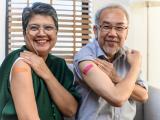Booster COVID-19 vaccination was tied to a 57% reduction in cases among 2,613 National Basketball Association (NBA) players and staff who were regularly screened for infection during the Omicron variant surge, according to a research letter published yesterday in JAMA.
Led by scientists from IQVIA and Johns Hopkins University, the study compared rates of COVID-19 among fully vaccinated NBA players and staff who did and didn't receive a booster dose and were tested more than once from Dec 1, 2021, to Jan 15, 2022. Testing was routinely conducted after an exposure to the virus and daily amid a cluster of cases on a team.
While players weren't required to be vaccinated, staff were mandated to be fully vaccinated by Oct 1, 2021, and receive a booster dose by Jan 5, 2022, if eligible. Full vaccination was considered two doses of the Pfizer/BioNTech or Moderna COVID-19 vaccines or one dose of Johnson & Johnson.
Players and staff had to wear face coverings, except for players on the court and head coaches during games. As of Dec 21, 2021, boosted participants had received their last dose a median of 20 days earlier.
85% were boosted by study end
Among the 2,613 players and staff, 67% were monitored for all 45 days of the study, with fully boosted participants accounting for 74,165 person-days and those who were fully vaccinated but not boosted despite being eligible accounting for 10,980 person-days. Median age was 33.7 years, and 88% were men.
Over the study period, the proportion of fully vaccinated but not boosted participants fell from 682 (26%) to 205 (8%), while the proportion who were boosted rose from 1,282 (49%) to 2,215 (85%). The remainder of participants fell into other categories, such as fully vaccinated but not eligible for a booster or within 14 days after their booster.
Boosted participants experienced 608 COVID-19 infections and were at significantly lower risk of infection than those who hadn't received a booster. The not-boosted group had 127 infections, for an adjusted hazard ratio (aHR) of 0.43 (95% confidence interval [CI], 0.35 to 0.53).
A secondary analysis of symptomatic infections found a comparable reduction (aHR, 0.39; 95% CI, 0.30 to 0.50)—or a 61% reduction. No participants were hospitalized or died. Omicron was the causative virus in 93% of sequenced cases.
"Surveillance testing in this population captured both symptomatic and asymptomatic infections, which differs from studies of the effectiveness of boosters that did not assess risk of asymptomatic infections," the researchers wrote. "Continued research is required to assess the need for additional booster doses beyond a single booster dose."




















